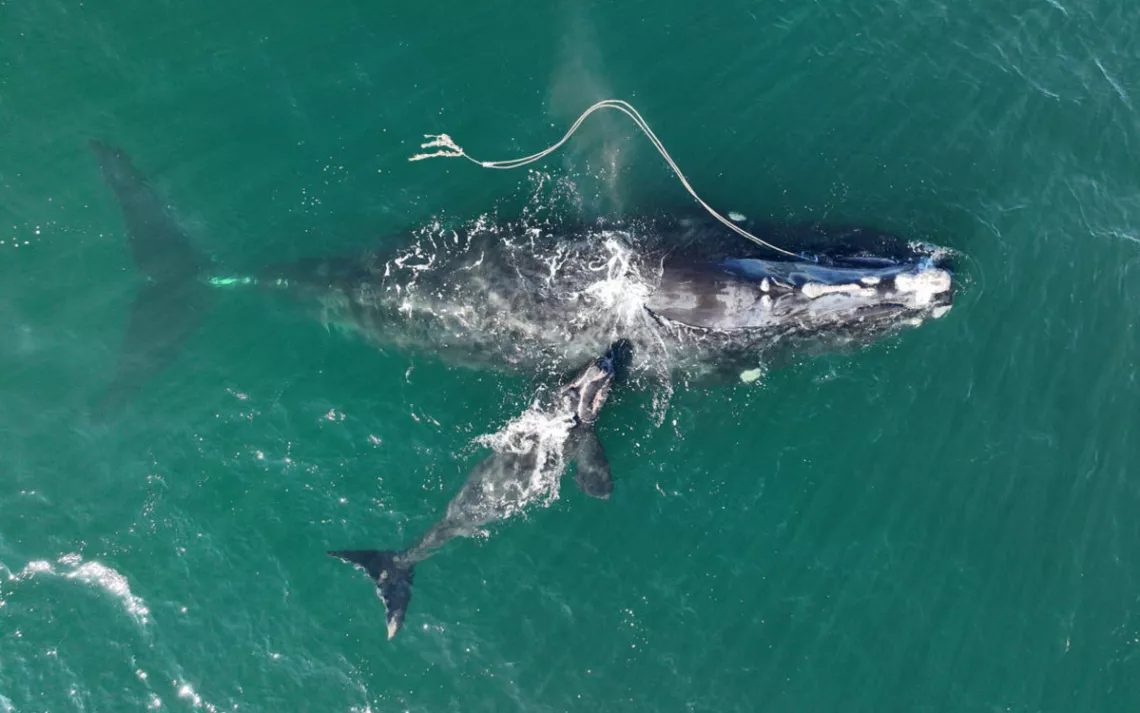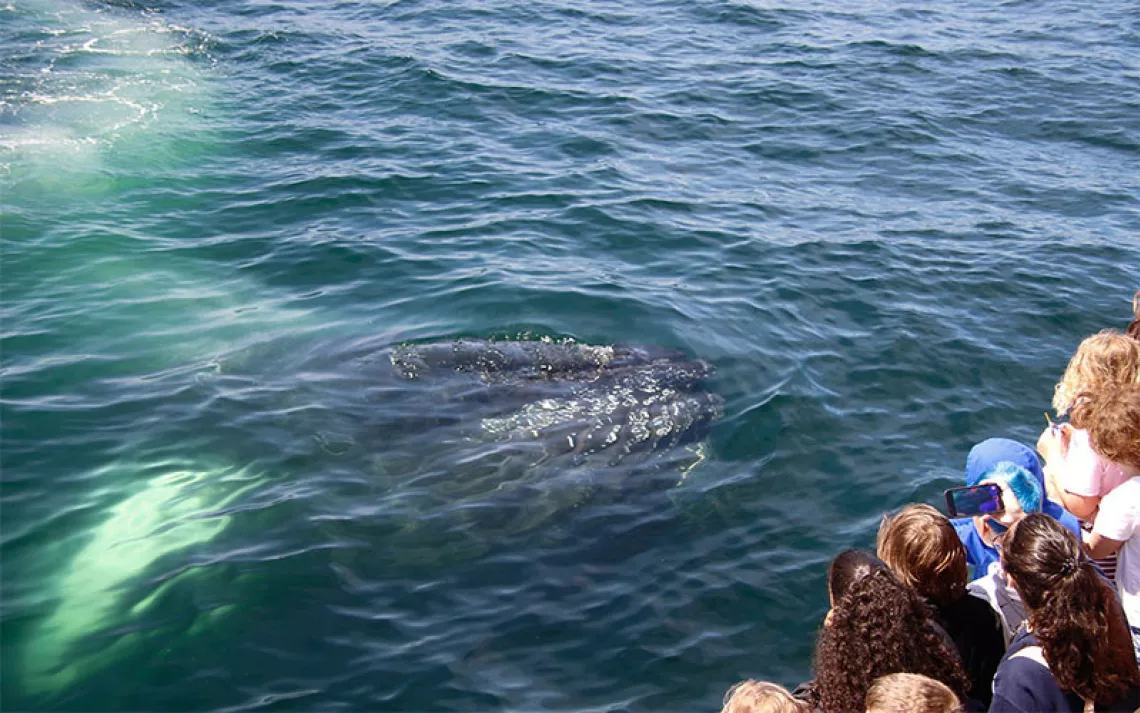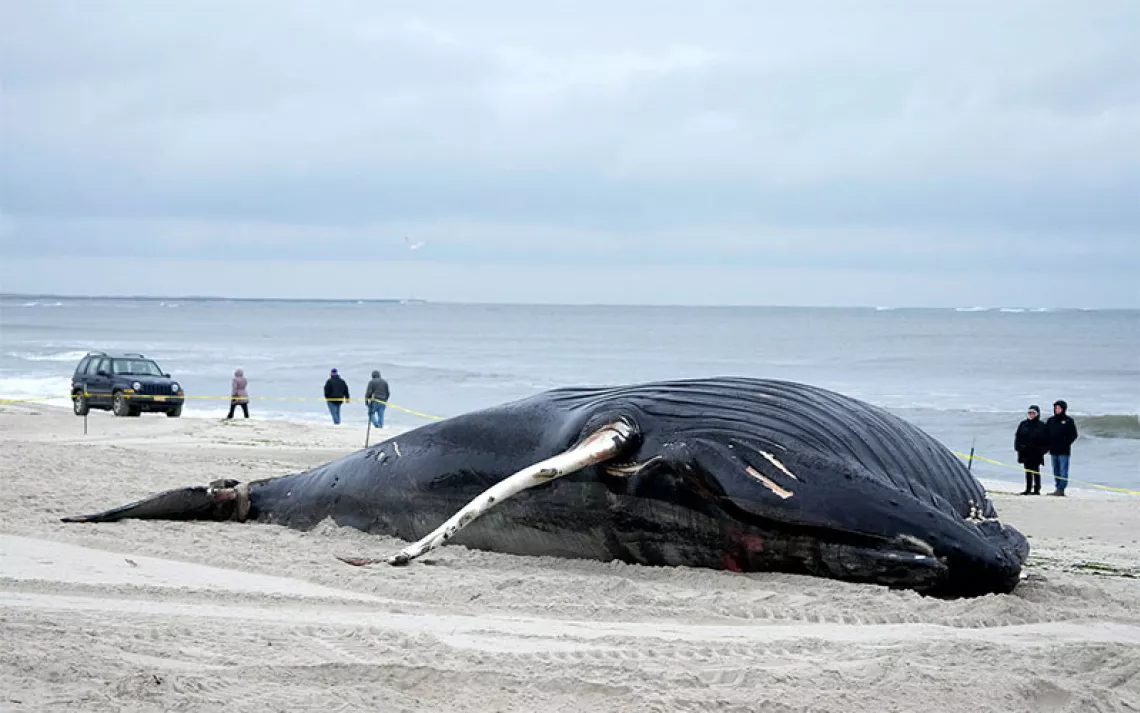North Atlantic Right Whales Are Dying at Alarming Rates
Here’s what advocates and the Biden administration are doing to help save them

A North Atlantic right whale mother named Snow Cone with a new calf in 2021 off the coast of Cumberland Island, Georgia. She had also been entangled in fishing rope for months despite disentanglement responders' attempts to free her. | Photo Credit: Georgia Department of Natural Resources, taken under NOAA Permit #20556.
In their first half-year of life, many North Atlantic right whales traverse a gauntlet over 1,000 miles long in their quest for food. New mothers leave their warm, winter breeding waters off Florida, Georgia, and South Carolina and cross busy East Coast shipping lanes on their annual migration to Canada with their calves in tow. In doing so, they run the risk of fatal ship strikes and entanglements with ropes, threats that have pushed this species, now numbering fewer than 360 individuals, to the brink of extinction.
"It's been a rough year for right whales," said Benjamin Grundy of the Center for Biological Diversity. "We've seen vessel strikes; we've seen entanglements; we've seen calves gone missing."
Earlier this year, a newborn calf was spotted with propeller wounds around its head. When people later spotted the calf with its mom, a well-known whale named Juno, some hoped the young whale might recover. But in March, Juno was spotted without her calf, and the following day, the calf’s body washed ashore on a Georgia island. Researchers who performed a necropsy determined that Juno's calf had been hit by a 35–57-foot boat.
As a result of the incident, the Center for Biodiversity sued the National Marine Fisheries Service in an attempt to push for a deadline on a federal rule that would require slower vessel speeds and reduce boat-whale collisions. But the rule, first proposed in 2022, has yet to be finalized.
“The saddest aspect of the last several years is the avoidable deaths of calves that didn’t even make their first birthday,” Erica Fuller, senior counsel at Conservation Law Foundation, said in a statement released in February. After some 57 meetings with stakeholders, the vessel speed rule remains listed as "pending review" by the Office of Management and Budget and the Office of Information and Regulatory Affairs.
“The Biden administration’s delay in finalizing the expanded vessel speed rule to protect right whales from lethal collisions is simply shameful,” said Jane Davenport, senior attorney at Defenders of Wildlife. “We question whether the White House really wants to protect right whales from approaching extinction or whether it’s willing to sacrifice an entire species on the altar of political expediency.”
Another failing of the current rule is that it only applies to boats 65 feet or longer. It could not prevent the 57-foot boat from mortally wounding Juno’s calf, but the proposed rule might have saved the young animal because it makes whale-safe speed limits mandatory, instead of the current voluntary rule, and applies to boats 35 feet and up.
When North Atlantic right whales leave their rest stop in Cape Cod for Canada, they face another peril that Dr. Michael J. Moore, a senior scientist at the Woods Hole Oceanographic Institute, considers even more devastating than ship strikes: lobster gear. The gear consists of vertical ropes (also called lines) that run from surface buoys to lobster traps on the sea floor. At peak lobster season the coastal waters of New England present a labyrinth of these ropes, or lobster lines, over 800,000 strong.
When a 40- or 50-foot right whale hits a line, Moore says, their instinct is to twist or “spin” and dive down. This hapless escape response can cause rope to wind in a stranglehold around a tail, flipper, or mouth, leaving the whale to drag any attachments—sometimes hundreds of pounds of lobster traps—behind it.
“You can’t heal while you’re still towing gear around,” Moore told Sierra. “Even minor entanglements have a major impact on the breeding success of the animal.” According to Moore, as many as 85 or 90 percent of the world’s remaining North Atlantic right whales have experienced some kind of entanglement. “Some have been entangled eight, nine, 10 or even 12 times,” Moore added.
In late January, a deceased female whale washed ashore just south of Cape Cod with lobster fishing rope embedded in her tail. The necropsy reported her condition as thin and that entanglement in lobster gear was a contributing factor to her death. It was likely a slow death by stress, deteriorating health, and malnourishment.
To address entanglement, the National Marine Fisheries Service (a division of the National Oceanic and Atmospheric Administration) has rules that call for closures of designated lobster fishing grounds during whale season. Waters around Cape Cod, for example, are closed to most lobster fishing until the whales leave in May. The closures are understandably contentious among lobstermen. One fishery blames another for the whale deaths. For years, Maine lobstermen claimed there was no scientific evidence that their fishery had caused a single right whale entanglement.
Using this argument, Maine’s $2 billion lobster industry filed suit against the mandated fishery closures. When they lost this suit, they filed a federal appeal. While court decisions went back and forth, NOAA Fisheries implemented a lobster line color-coding system by state. The January autopsy revealed that the entangled rope around the female whale had the purple markings of lobster gear from Maine. It was an important finding. Unfortunately, the evidence provided by the purple marking arrived too late.
Despite the National Marine Fisheries Service's federal mandate to protect these whales under the Endangered Species Act, the appellate court issued a decision in June 2023, barring the service from making any new rules to protect North Atlantic right whales until 2029.
“We’re in a long dark tunnel right now,” Moore told Sierra. “Tying the hands of the National Fisheries Service for five years—there’s no way you can put a positive spin on that.” In the wake of the legal proceedings, Monterey Bay Aquarium’s Seafood Watch red-listed Gulf of Maine lobster, filing it under “AVOID,” despite strong protests from the state's lobster associations. Perhaps the protests hint that sustainability certifications, along with conscientious consumers, do have an impact.
The pressure to reduce whale entanglements has led to seemingly positive momentum. Using digital signaling, lobstermen can use ropeless gear that enables the traps to rise from the ocean floor on demand. If fishers work with fishery managers and gear developers to make these systems feasible, they could eliminate thousands of vertical lines. Early on, fishers were resistant to the new gear. But Grundy senses a shift going on, an uptick in willingness to test and report on new gear technologies.
“Across the country, there’s been a momentum that’s come out of nowhere,” Grundy said. Government funding is making the gear more accessible to working fishers.
Even Maine's Department of Marine Resources (DMR) has signed on, stocking their gear library with a wide array of new ropeless systems. The DMR is permitted to set up 65 experimental fishing boats according to Kevin Staples, the DMR marine resource scientist overseeing the program. Already 12 lobster fishers are testing the innovative equipment, and Staples thinks once the word gets out, this lending library will take off. "Fishermen are interested in participating because they want a stable financial future and access to areas they have traditionally fished," Staples said.
For now, things are looking up. The count of new calf sightings for the 23/24 birthing season is up to at least 20 at the time of publishing. For a population of under 70 breeding females, it's a veritable baby boom. Survey teams in Cape Cod Bay have spotted at least five healthy mother-calf pairs. These newborns promise hope. The species' overall health is also showing promise.
'"We've got some unpublished data that is suggesting that the body condition is improving a little bit over the last few years," Moore said. “That is nicely correlating with the reasonable calving we’ve had this year."
Having spent 40 years researching right whales through hope and peril, Moore calls it “gentle good news.”
 The Magazine of The Sierra Club
The Magazine of The Sierra Club



